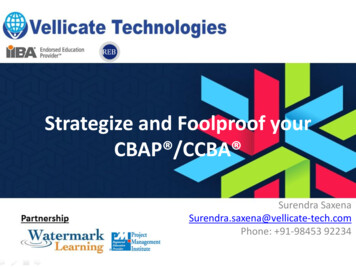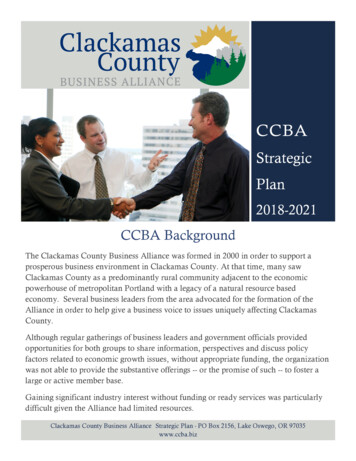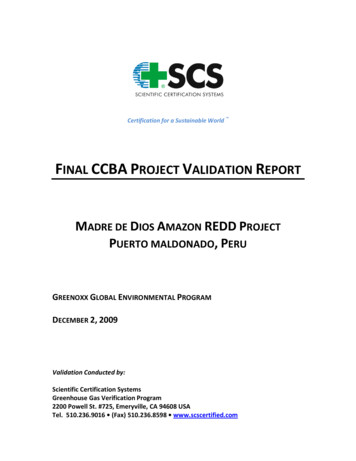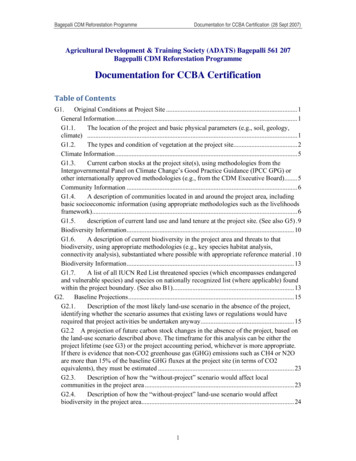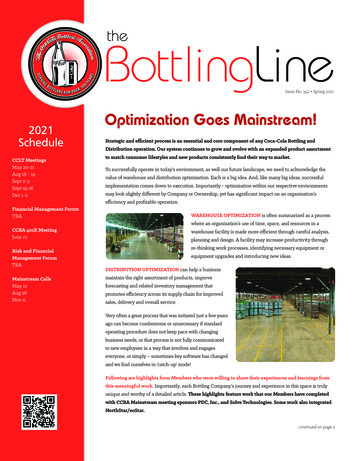
Transcription
theBottlingLineIssue No. 342 Spring 20212021ScheduleCCLT MeetingsMay 20-21Aug 18 - 19Sept 2-3Sept 15-16Dec 1-2Optimization Goes Mainstream!Strategic and efficient process is an essential and core component of any Coca-Cola Bottling andDistribution operation. Our system continues to grow and evolve with an expanded product assortmentto match consumer lifestyles and new products consistently find their way to market.To successfully operate in today’s environment, as well our future landscape, we need to acknowledge thevalue of warehouse and distribution optimization. Each is a big idea. And, like many big ideas, successfulimplementation comes down to execution. Importantly - optimization within our respective environmentsmay look slightly different by Company or Ownership, yet has significant impact on an organization’sefficiency and profitable operation.Financial Management ForumTBAWAREHOUSE OPTIMIZATION is often summarized as a processwhere an organization’s use of time, space, and resources in aCCBA 401K MeetingJune 17Risk and FinancialManagement ForumTBAMainstream CallsMay 12Aug 26Nov 11warehouse facility is made more efficient through careful analysis,planning and design. A facility may increase productivity throughre-thinking work processes, identifying necessary equipment orequipment upgrades and introducing new ideas.DISTRIBUTION OPTIMIZATION can help a businessmaintain the right assortment of products, improveforecasting and related inventory management thatpromotes efficiency across its supply chain for improvedsales, delivery and overall service.Very often a great process that was initiated just a few yearsago can become cumbersome or unnecessary if standardoperating procedure does not keep pace with changingbusiness needs, or that process is not fully communicatedto new employees in a way that involves and engageseveryone, or simply – sometimes key software has changedand we find ourselves in ‘catch-up’ mode!Following are highlights from Members who were willing to share their experiences and learnings fromthis meaningful work. Importantly, each Bottling Company’s journey and experience in this space is trulyunique and worthy of a detailed article. These highlights feature work that our Members have completedwith CCBA Mainstream meeting sponsors PDC, Inc., and Solve Technologies. Some work also integratedNorthStar/eoStar.continued on page 21
Optimization Goes Mainstream!continued from page 1 Significant reduction in training time. A new employee can now be trained independently in 2-3 days. Before the optimization work, ittook 2-3 weeks to train a new employee. The racking system has significantly optimized warehouse storage space and inventory control. Each individual sku now has adesignated pick location, including nearly 600 roller case flow bays for slower moving items. The roller bays and floor position bays canbe filled, and the remaining product is placed in the overhead pushback rack locations. The pick Kiosk, and RD product palletization delivery system enables a more efficient build process and better management ofovertime hours. All order builders now use walkie/riders instead of forklifts, which have proven to be more efficient and create a safer workenvironment. Loading accuracy has improved. Employee morale has improved greatly with a slight decrease in employee turnover rate. Although the physical workload hasn’t goneaway, installing the pick Kiosk lessened the “mental workload and thought process” for the order builders.Contact Patrick Forster, General Manager & CFO (pforster@mccbw.com) if you want to learn more about Middlesboro Coca-Cola’s approach tothis work. Improved warehouse layout to save time. Macon used their unique sales data to identify improvements for layout and create a flow frompackage to package – and then to the staging area, so a picker never had to back track. Increased accuracy in picking and order fulfillment. Macon began using a product slotting and labeling system so products could bepicked by a simple slot number rather than by the package identity only.Distribution Optimization Highlights Predictive Vending enabled Macon to better estimate when to service a vending machine based on their minimum case drop.Predictive Vending enables building specific orders for each vending machine, rather than picking from a standard daily base load on thetruck. EoStar predicts what is needed for each machine based on actual sales and par levels in the machine. Filling Vending Machines by the Unit increased overall service efficiency and product usageMacon fills each vending machine by a single unit, rather than a full case or a half case. This lets their team completely fill a vendmachine --- which reduces the number of stops for each machine (and increases the time until a machine runs out of any particularproduct.) Partial cases are stored on the driver’s trailer to eliminate partial cases in warehouse inventory. These partial cases are used forvending stops the following day. Delivery Dispatch optimizes delivery stops in a specific order that make the most sense geographically, saving driver time bymapping out the stops the day before delivery.Macon discovered its vending route has more variety in stops from week to week than the Company’s other delivery routes. Deliverydispatch added efficiency to the entire route.Contact Erin Roberts, Marketing and Business Development (erinroberts@maconcocacola.com) if you want to learn more about Macon Coca-Cola’sapproach to this work.continued on page 32
Optimization Goes Mainstream!continued from page 2 Improved configuration solution for palletization saved hours of time and the typical frustration that can occur when the build is off. Improved warehouse layout and picksheets. Corinth’s team has re-thought and re-worked their picking areas, flow racks and thelayout of their picksheets. Key data points to help determine sensible flow rack selections and best routes to pick. The team is stillworking to refine their picksheet layout and exploring the best way to do this. Improved floor space management and the time spent to complete tasks was realized by exploring details around how we managedwork shifts, building certain pallets at specific times of the day and on certain shifts.Having seasoned operations professionals in your warehouse for multiple days, asking questions and taking notes brings an experiencedeye and objective thought that enabled our team at Corinth to focus on immediate opportunities and new ways of operating as weprogressed into the future.Contact David Bolton, Director of Operations (dbolton@corinthcoke.com) if you want to learn more about Corinth Coca-Cola’s approach to this work.The Chesterman team implemented optimization initiatives in the Company’s warehouse design, network and routing,essentially improving the efficiency of their entire operation. A detailed analysis of their operation resulted in recommendationsfor layout, slotting and sequencing of the pick area, integration of voice pick capability with an analytical overlay that provideda short and long term infrastructure plan. For a fully integrated optimization, consider developing an over-arching strategythat includes change management to communicate and support the broad modifications to associates’ day-to-day activities,along with providing opportunities for associates and front line employees to provide input. Pay attention and be sureto involve all stakeholders upfront and as work progresses, on everything from product storage to how long a lane should be.“Measure twice-cut once” can be words to live by during a project of this scope. It can be time-consuming and costly to makechanges afterwards. The racking system has significantly improved warehouse storage space and inventory control. Yes, racking can be costly butprovides huge benefits. The pick floor layout improved efficiencies, and slotting design enables the Build Crew to increase their case-per-hour outputand assemble accurate pallets with limited need for forklifts. This increased accuracy in picking which was also beneficial to themorning crew. Voice pick has increased order accuracy and pallet stability and overall better floor space management reduces the time spentto complete tasks.Contact Anne Lofgren, Director of Supply Chain (alofgren@chesterman.com) if you want to learn more about Chesterman’s approach to this work.continued on page 43
Optimization Goes Mainstream!continued from page 3Emporia’s team is working smarter with an optimized floorplan that can accommodate current volume as well as over 30% more skusover the next 2-5-10 and 20 years! Significantly improved pick timing and accuracy using iPads with Cool lift pallets. Associates are able to adjust a pallet on the pickfloor vs. having to return to the kiosk and enter necessary changes.Emporia purchased a new building to accommodate their growing business along with the expanding assortment of products andSKUs from The Coca-Cola Company. Jeff DeBauge emphasized that while there may be adjustments as the business moves forward, heand his team have not regretted their decision to implement warehouse optimization. In addition to key benefits, Jeff also shared keylearnings that have been echoed by other contributors to this article: It is important to think through every process and dimension, from packaging to truck dimensions. Build your routines and revisit your processes at intervals that help you assess opportunities to tweak/enhance your productivity.Contact Jeff DeBauge, CEO (jeff@emporiacoke.com) if you want to learn more about Emporia Coca-Cola’s approach to this work.The overwhelming message from the team at Ozarks Coca-Cola is not to wait to explore and implementoptimization initiatives in your business. The team enthusiastically shared that This work is well worthyour investment!Ozarks began working to optimize processes at their new facility in Missouri last year. The newfacility includes over 400,000 square feet of production and warehouse. The facility has opened inphases with the pick floor being first in this process. Detailed blueprints were developed as well asconsiderations and ways to look at the space over the next 10-20 years, including how racking isbuilt.While a good deal of this work is still in progress, Ozarks has reduced travel time on their pick floorand also reduced time on forklifts.The plan was significantly different than the Ozarks team hadever seen and there was some anticipation about how it wouldall work. Steve Williams, Vice President of Operations, OzarksCCBC emphasized the importance of building trust across yourorganization and giving new processes time. Importantly, involveeveryone in the process – to ensure that critical details areaddressed.Striping is also critical part of the processOzarks new warehouse accommodatesexpanded fleet optionsIt was a little intimidating at times, as the facility was over fourtimes as large as anything the team had ever worked with. So therewere plenty of questions and discussions on how to best navigatethe space, understanding that efficiency was their primary objective.There is much more to come on this work, as distribution optimization is also indevelopment. Ozarks produces a monthly drone video that captures the entire property andoptimization project progress. (See code on right)Contact Steve Williams, Vice President of Operations (swilliams@cocacolaozarks.com) if you wantto learn more about Ozark Coca-Cola’s approach to this work.4Ozarks new pick floorScan this code to viewdrone video footage thatcaptures progress at thenew Ozarks Coca-Colafacility:
2021 CCBA Mainstream Bottlers MeetingThe CCBA Spring Mainstream Bottler Meeting is traditionally held annually in Palm Springs, California. However, due to theon-going pandemic, for the first time in its history, this year’s meeting was held virtually on February 11 & 12. Although we trulymissed spending social time together, we were still happy to be able to hold the meeting, filled with great presenters and valuablecontent for our Members to learn about the latest system news, hear updates on business performance, share best practices andparticipate in Bottler-only discussions.Ilene Grimes, VP, Bottler Support Services & Customer Governance,CCBA, and Bruce Long, President of Ozarks Coca-Cola/DrPepper and our new CCBA Mainstream President, opened themeeting with a warm welcome and shared their perspective on themeeting’s theme, “Survive to Thrive”. They also provided highlightsand updates pertinent to our Mainstream Member audience.Importantly, as we officially welcome Bruce Long as our newPresident, and Rob Feeney, President & COO of Atlantic CCBC,as our Mainstream Vice President, we want to acknowledge andthank Bruce Hanna, President, Timber Country Coca-Cola, forhis leadership and support as CCBA Mainstream President forthe last two years.We are fortunate to have knowledgeable, seasoned and caringleaders who are willing to work with CCBA to advocate on behalf ofand represent our Mainstream Bottling Ownerships.The Coca-Cola North American Operating Unit (NAOU) Leadershipteam were our first guests of the day. Zoran Vučinić, ChiefOperating Officer, reviewed select highlights of 2020 businessperformance and introduced his leadership team. NAOU coversfour Geographic Zones, connected to Commercial Leadershipand Franchise Governance & Development. The new structure isdesigned to provide a network connection across our system and anincreased focus on executing strategy. Each of the Zone Presidentsintroduced their respective team leaders and reviewed operationalbusiness details specific to their zones, including highlights of theirkey Customers and Bottlers within their geography. Andrew (Andy)McMillin, Chief Commercial Officer, then offered a detailed view of2020 business performance and how both the business results andthe pandemic have shaped the upcoming 2021 programs.An NPSG/NDTP/Product Supply Update with Bottler Q&A wasfacilitated by Rob Feeney, NAOU’s Mickey Urmann, DirectorCCNA Exchange, Darin Rice, VP Franchise Operations and BottlerCapability and Janetta Lavender, Senior Director Procurement,CCBSS. This discussion covered allocation methodologies, forecastdemands, constraints and capacity assessment for the balanceof 2021. Can inventory continues to be a critical topic across oursystem and the session elicited productive discussion and points ofview from many Mainstream Members.Darin Rice kicked off the next session, sharing updates on Bottlercapability tools/resources (Total Beverage Essentials; RED; PicOS).The meeting then moved into Bottler Best Practices with the NAOUOffline-To-Online (O2O) Team sharing information related to howMainstream Bottlers can begin to think about and get engaged withtheir local Click & Collect, Grocery Intermediaries and RestaurantDelivery Intermediary opportunities. The team also shared systemtools available to Bottlers to drive local business in this space.As our system readies for the FSOP channel to reopen, there ismuch to be done in a somewhat unknown environment. ManyBottlers have asked for ideas and learnings on how best to work withand support their local FSOP customers. Scott Ites, Vice President,On-Premise, Atlantic CCBC and Travis Sarich, Senior Director Sales& Services, Heartland CCBC, shared initiatives their ownerships arecurrently implementing to boost activation locally in a variety ofcreative ways that reinforce and grow our brands, as well as connectwith local businesses and their employees to support and reactivateFSOP in a post-Covid business environment.Day one concluded with a CCBA Update & Stewardship Report byJohn Gould, CCBA Executive Director & CEO, and a highly engagingBottler discussion.Very special thanks to CCBA’s sponsors of the 2021 Mainstream Bottlers MeetingOn day two, CCBA welcomed Jason Butter, Sr Vice President CASORTM Sales, KDP and his leadership team, to present an update onthe Dr Pepper Business in a CASO-only Bottler Session. The KDPteam leaders briefly reflected on 2020 successes and opportunitiesbefore shifting the conversation to the highly anticipated launchof Dr Pepper Zero Sugar and the balance of 2021 marketing plans.The separate forum provided an opportunity for questions andMainstream Bottlers’ feedback to the CASO leadership team. Aftera short break, Bruce Long opened the general session welcomingeveryone back and reviewed the agenda. He then introduced JohnSherman, President & CEO, CCBC UNITED, Troy Taylor, CEO, CCBFlorida and Lori Morrow, Senior Manager Franchise Governance,NAOU, for a discussion on our US System efforts to support socialand economic justice. Troy kicked off the discussion with a powerfuland genuine commentary and then both he and John providedvaluable points of view and shared considerations for conversationcontinued on page 65
2021 CCBA Mainstream Bottlers Meetingcontinued from page 5as we navigate current events in our business environments. Lori walked the audience through how the Company has historically supportedand addressed this pivotal issue and shared steps The Coca-Cola Company is taking to lean into, engage and prioritize diversity, inclusion andracial equity. Lori also shared resources available to Bottlers of Coca-Cola for additional information and support for enabling action in theirbusinesses and communities.The next guests were the BODYARMOR leadership team, led by Paul Lukanowski, COO, to discuss the brand’s successful 2020performance and exciting 2021 brand news. He provided a deeper dive into BODYARMOR’s business plan, key Customer wins andperformance details across their portfolio. The launch plan for Edge was reinforced, with an expectation that more exciting news is tocome. Discussion followed regarding the news of the announced acquisition of BODYARMOR by The Coca-Cola Company.Monster’s Emelie Tirre, President of the Americas, and her team took attendees through the Monster portfolio 2020 performance details, 2021programming, innovations, news across the category and compelling insights showing how the energy category is poised for growth.A key takeaway and exciting statistic was that Mainstream Bottlers represented Monster’s greatest volume growth for the year, with amajority of the Mainstream Bottlers outperforming the national volume growth percentage.The final session of the meeting, was the Bottler-only discussion facilitated by Bruce Long, Ilene Grimes, Rob Feeney and John Gould.Member dialogue covered a wide range of topics with particular focus on can supply.Bruce Long officially adjourned the meeting, letting Members know that we look forward to seeing everyone at next year’s meeting.inPalm Springs!Scan the code to review and downloadselect presentations from the meeting(password necessary):CCBA’s goal is to facilitate meaningful Mainstream meetings that benefitour Bottling community and encourage full participation by all Mainstreammembers. We appreciate everyone who took time to complete the onlinesurvey feedback and will use this to inform next year’s session!Welcome the 33rd Class of Coca-Cola Scholars!The 2021 virtual Coca-Cola Scholars Celebration took place on April 15. We hope you were able to join thestudents, sponsors, and your system colleagues in officially welcoming this new class of future leaders.From 99,403 applicants across the country to 1,609 Semifinalists to 251 Regional Finalists, the Coca-Cola ScholarsFoundation (CCSF) recently announced the 2021 class of 150 NEW Coca-Cola Scholars!Each Scholar receives a 20,000 college scholarship and joins an extended family that fosters lastingconnections with the Foundation and each other. Coca-Cola Scholar alumni stay in touch through leadershipdevelopment opportunities, special events, and through their local Coca-Cola Bottlers. Alumni often unite to organize and implementcommunity service projects that enable them to make an even greater impact together.If you are new to having a Scholar in your territory, don’t hesitate to reach out to theCoca-Cola Scholars Foundation Team for assistance. Given that many schools remainvirtual and some hybrid, it is likely that there will not be traditional awards ceremoniesfor these Scholars. If you would like to arrange a safe event to meet your Scholar(s),you may download and adapt the customizable certificate. This certificate and othertools can be found in the comprehensive Bottler Toolkit that provides resources andtemplates to activate Scholars activities in your market. The toolkit is available throughthe Scholars Foundation team or your local PAC representative.The Coca-Cola Scholars Foundation is the largest achievement-based and corporatesponsored scholarship program in the country. With the addition of the 2021 class, theCoca-Cola Scholars Foundation will have provided more than 6,450 Coke Scholarsnationwide with over 75 million in scholarships over the course of 33 years.If you have any questions, please contact Jamie Williams, (jwilliams@coca-cola.com)CCSF’s Director of Scholarships.6Scan code for ScholarsCertificate Template:Scan code for a list of2021 scholars:
Your Family Owned BusinessWelcoming Up and Comers of the Next GenerationBy Christopher J. Eckrich, Ph.D., Amy SchumanIn a previous article, we explored processes for welcoming spouseswho may be new to the enterprising family and its meetingprocesses. The rising generation of family members coming upthrough high school, college and young adulthood also need tobe welcomed and educated about the nature of the family andrespective businesses. Families seeking ownership continuity findways to engage the rising generation who are often very busy withschool, new jobs and living a full life. We see a variety of excitingand effective ways that families engage their rising generations.DIRECT ENGAGEMENT IN THE FAMILY BUSINESS –SUMMER JOBS AND INTERNSHIPSEnterprising families often encourage high school-aged familymembers to work summer jobs in the family business to gain ageneral understanding about the business. They can also offercollege-aged family members internships that are a more intenseimmersion focusing on a specific aspect of the family business.Ideally, internships align with the college-aged family member’sinterests and support the individual’s career direction. Still, the goalof the internship is exposure to the enterprise and learning moredeeply the culture of the business. Internships work best when workresponsibilities are well defined, reporting relationships are clear,and the intern both receives feedback at the end of the internshipand is asked to present a summary of their experience, including keylearnings and observations.Often, high potential, rising generation family members whomeet the family employment policy requirements are directlyrecruited to come into the enterprise. These families are interestedin building family talent within the enterprise and may hirerising generation family members to engage in a specific area ofthe business (Operations, Marketing, PR, Finance, Accounting,Customer Service, IT, etc.).Alternatively, new hires may enter a rotational managementprogram for rising generation family members who wish togain a broad exposure to their business for eventual placement.Rotational programs require significant advance work to definethe rotations, create real work opportunities, clarify desiredoutcomes and reporting relationships, and monitor progress.Family members rotating through the various functions of thebusiness usually seek placement into an area of the companybased on mutual agreement while balancing the risinggeneration’s interests and company’s need. Rotational programsare often used to prepare family members for governance roles asdirectors or family council leaders as well.SHADOWINGAnother learning-focused work opportunity is where familymembers learn about various parts of the company byshadowing one or more executives. These experiences aretime-limited and generally culminate with the young shadowerproviding feedback to the owner or family on what was learnedand whether they would be interested in pursuing a career inthe firm. This approach is often used for late high school or earlycollege-aged students who want to explore various aspect of thework world during a school break or other limited timeframe.While they do not necessarily need to shadow someone in thefamily’s business, it does provide for the opportunity to discovermore about the family business’s culture and work processes whilelearning about an occupation.Participating in industry-related activities is another good methodfor young family members to learn about their business and itsplace in the marketplace. Typically, these experiences are offeredto college-aged students, but not mandated. Allowing the risinggeneration family member to opt-in is important so as not to createan experience of negative pressure. Many trade associations have“next gen” programs, usually for young adults who are post-college.Many business owners with active boards of directors create boardobserver seats to allow the next generation to learn how the boardfunctions. While some may do this as a way of training up-andcoming family board members, it also is a meaningful, rich learningexperience for future owners who may never serve as a director.To derive the full learning possibilities from these experiences,many families schedule pre-meeting calls where board observerscan review the board packet with a knowledgeable director orbusiness executive, and then also post-meeting calls where theboard meeting can be debriefed for maximum learning. It isimportant to clarify boardroom protocol and the observer roleprior to the meeting so observers are clear about whether they canask questions or participate in discussions. For most, observers arejust that — there to pay attention, listen attentively and learn butnot fully participate in board discussions. These experiences aregenerally offered to rising generation family members after theyhave completed their formal education.continued on page 87
Welcoming Up and Comers of the Next GenerationSTRUCTURED, ACTIVITY-BASED EDUCATIONWhen a family business has a large number of rising generationfamily members, they may create specific learning activitiesdesigned to expose the next generation to the businessand simultaneously build their teamwork. Typically, theseopportunities are offered to late college or post college-age upand-comers. Both family and non-family executives can providesupport for this kind of activity. We have seen a number ofdifferent approaches to this, including: Dissect the vetting of a new business opportunityor investment. Develop a marketing or social media plan for a product orservice now provided by the company Conduct a key competitor analysis and make a presentation to theexecutive team or a shareholder group. Create a set of scenarios for how the business will look 20 yearsfrom now. The executive group assigns the next generation groupa real problem for them to consider and solve or makerecommendations on. Ideally, the question the cohort grouptakes on is something the business is currently wrestling withand the cohort group will make a formal presentation about thematter, concepts to consider, recommendations and next steps.GENERAL BUSINESS EXPOSUREWe know of family businesses where the senior generationrealizes that it is important for the rising generation group tobegin working on teamwork, long before they become activeshareholders. A few interesting approaches include: Start a next generation investment club with seeded money,overseen by those interested in the concept. The goal here is tolearn about investing, and the club will need rules so teamworkresults from working through the rules of the game and ongoinginvestment review and decision making. Create a limited investment pool that next generation familymembers can tap into for new business creation. This wouldrequire significant clarification of rules for application,methods of review and oversight, accountabilities, and definedrelationship between funder and receivers. As the goal is toencourage collaboration among rising generation members,preference can be given to those concepts submitted bymultiple family members. While some may prefer a sink orswim approach (go make it work!), senior family leaders canalso serve as an informal advisory board should the up-andcoming investors request this feature. Because the goal of thisactivity is learning , recouping investment capital and growingassets is considered a bonus rather than the primary focus ofthis approach. Please note that this concept is very differentthan when families create an investment pool of family assetsand allow younger generation family members to pursue wealthbuilding opportunities.8continued from page 7 Private equity research for new investments, overseen by familymembers who have talents in this area. Collective service projects, such as Habitat for Humanity, thatthe group can complete as a team.CONCLUSIONWe often hear elder family business leaders express concernthat their children or grandchildren do not understand theimportance of the family enterprise to the family or to society atlarge. They wish everyone had greater passion and appreciationfor the enterprise and all it takes to make it successful. In truth,you can’t love something that you do not know well. It is ourhope that the concepts presented in this article will help younurture a knowledgeable, well-educated and appreciative futureownership group.CONSIDER THE FOLLOWING TO BEGIN THIS JOURNEY: Gather the parents and grandparents of the up-and-cominggeneration to determine whether engaging the next generation isa worthy goal that all can support. Identify the types of engagement that up and comers couldreasonably participate in given the state of the business, andbusiness resources and family leader
4 Optimization Goes Mainstream! continued from page 3 Emporia's team is working smarter with an optimized floorplan that can accommodate current volume as well as over 30% more skus over the next 2-5-10 and 20 years! Significantly improved pick timing and accuracy using iPads with Cool lift pallets. Associates are able to adjust a pallet on the pick




